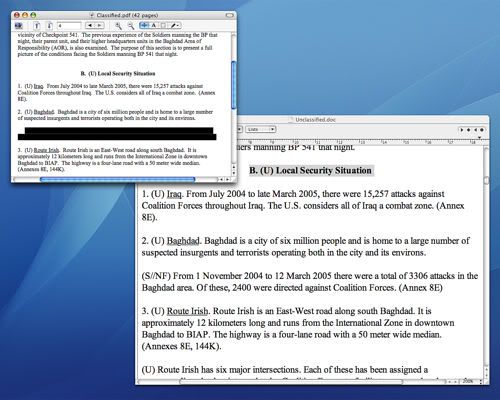Edit. Find in this page. Replace all.
What's a military intelligence officer to do when redacting sensitive material in an electronic document?
These poor guys have been trained (at great expense) to use US Gov't. approved Black Magic Markers (See Photo), dontchaknow?
When the blind lead the blind, redactors follow orders from above, which must be the explanation for the procedural directive to redact portions of the official US report on the Italian journalist checkpoint fiasco.
Some Bozo (no offense to real clowns intended) thought s/he had a scathingly brilliant idea: redact info by changing the font color to the color of the page background.
The problem: the redacted text is still there. All you have to do is cut & paste the text into an MSWord doc or into your typepad.
Et voilà! Since the background color is different now (probably white or transparent), the (not so) cleverly "redacted text" is completely visible.

Of course, the New York Times (aka White House stenograhphers) offered this explanation:
The report, which had many blacked-out parts, is the American military's first detailed account of the events. It asserts that the Italians ignored repeated warnings from American soldiers as they sped onto a part of the Baghdad airport road where soldiers are on a constant state of high alert because of the extraordinary risk of suicide car bombs and other insurgent attacks.
According to the report, 11 bullets fired by one American soldier hit the Italians' car, killing Mr. Calipari, after the car failed to heed the warnings. The car was traveling about 50 miles per hour - faster than other cars that night - as it approached the checkpoint and did not slow until struck by the bullets, the report said. LINK
By the way, here are the Italians' objections to the official US incident report:
1. Highway lighting system was turned off.
2. A 3-second interval between spotlight and warning shot is insufficient for a car traveling at 60MPH on a rain-slick road surface to stop.
Note: 60MPH in Kilometers is roughly 36MPH; hence, a possible explanation of the confusion... and I don't trust the Pentagon not to obfuscate. Do you?
Oh, and there's the pesky little fact that the Pentagon uses Kilometers in their redacted/unredacted report!
3. There is evidence that three soldiers fired at the car, not 1 as claimed by USA
4. The blocking checkpoint is for use on the battlefield, where you shoot at anything that moves. It is not exactly a "checkpoint."
5. The checkpoint vehicles were hidden in the overgrowth, violating the rules of engagement which say a checkpoint must be visible.
6. US Command and the CIA were informed that the car was heading to the airport.
Note: An Italian jet was fired up and waiting at the Airport... with the full consent of US military command.
7. The scene of the crime was re-arranged before the Italian team could inspect it.
8. There was no signage of any kind.
9. The story of a satellite monitoring the speed of the car was disinformation from the Pentagon.
Note: Remember when Colin Powell and Donald Rumsfeld showed us satellite photos of identified WMD sites?
10. The Italian victims in the car specifically asked US Command by telephone if there were any checkpoints to be traversed. The answer was "NO."
11. The Pentagon claimed it could not be determined who was assigned to patrol that night.
Sadly, friends, the accidental (or was it intentional?) attack on the freed Italian journalist's car is not the most troubling aspect of the redacted/unredacted info contained in the report!
Neatly nestled inside the report were these gems:
(U) Local Security Situation
1. (U) Iraq. From July 2004 to late March 2005, there were 15,257 attacks against Coalition Forces throughout Iraq. The U.S. considers all of Iraq a combat zone. (Annex 8E).
2. (U) Baghdad. Baghdad is a city of six million people and is home to a large number of suspected insurgents and terrorists operating both in the city and its environs.
(S//NF) From 1 November 2004 to 12 March 2005 there were a total of 3306 attacks in the Baghdad area. Of these, 2400 were directed against Coalition Forces. (Annex 8E)
4. (U) Effectiveness of Attacks
(U) The number of IED detonations from 15 June 2003 through 4 March 2005 (the date of the incident), has steadily increased. Although the effectiveness of those detonations has decreased over that timeframe, the overall average number of casualties during that period is nearly one per IED detonation. (Annex 4E).
(S//NF) The week of the incident saw 166 IED incidents, with 131 detonations and 35 IEDs rendered safe. There were 82 casualties from those incidents. (Annex 4E).
(U) The number of VBIED detonations from 15 June 2003 through 4 March 2005 has also seen a relatively steady increase. Similar to the decrease in the effectiveness of IEDs, the effectiveness of VBIEDs has also decreased over that period, but there have been spikes for particular VBIED events that have produced large numbers of casualties.
From Lance McCord...
That works out to an average of just over 25 attacks a day, with more than 18 attacks on Coalition forces every day. In the Baghdad area. A day.
So play Revolutionary/Terrorist Commander. How many insurgents would you need to pull off 25 attacks a day for 4.5 months in a single metropolitan area, with 18 of those daily attacks against the finest military in the world? Be sure to make reasonable allowances for:
- insurgents killed or captured by US forces and those killed or captured by the new Iraqi police forces;
- the fact that the 4.5 month period begins after the Coalition has been in the city for about one and a half years and that the Coalition has, in that time, presumably been making your job as difficult as they reasonably may;
- the elections 2/3 of the way through your 4.5 month period, with the associated increased security and diminished support of local residents.
To receive full credit, you'll need to provide a working definition of the word "attack."
There are probably several ways to redact info on an electronic document. The best way, in my opinion, would be to render the document pages as image files (like George W.'s Texas Air Nation Guard documents).
You could also create an MSWord doc file and follow the instructions in my post title (replacing parts you want to redact with XXXX's) BEFORE you turn it into a PDF file.
Heavy (The Morons Are In Charge!) sigh.







0 Comments:
Post a Comment
<< Home